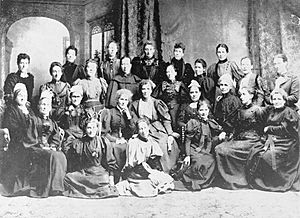Margaret Sievwright facts for kids
Quick facts for kids
Margaret Sievwright
|
|
|---|---|
| Born |
Margaret Home Richardson
19 March 1844 Pencaitland, Scotland
|
| Died | 9 March 1905 (aged 60) Gisborne, New Zealand
|
| Organization | National Council of Woman of New Zealand |
| Movement | Women's suffrage |
| Spouse(s) | William Sievwright |
Margaret Home Sievwright (born Richardson; 19 March 1844 – 9 March 1905) was an important New Zealand leader and activist. She worked hard for women's rights and was a community leader. She was very active in movements that wanted to give women the right to vote. She also became the president of the National Council of Women of New Zealand.
Contents
Early Life and Education
Margaret Home Sievwright was born in Pencaitland, East Lothian, Scotland, in 1844. Her father, John Richardson, managed a large estate. Her mother was Jane Law Home. Margaret grew up near Edinburgh.
She studied classical writings and the Bible, which helped her develop ideas about fairness and human rights. Throughout her life, she loved learning and working to make society better. She especially wanted to improve things for women and children.
Becoming a Teacher and Nurse
Margaret first became a teacher. She worked at "ragged schools" in Edinburgh. These schools helped poor children who might not have had other chances to learn. Later, she trained to be a nurse using the methods of Florence Nightingale. As a nurse, she joined a campaign led by Josephine Butler. This campaign worked to protect women's health and rights in both Britain and New Zealand.
Moving to New Zealand
In 1878, Margaret moved to Dunedin, New Zealand. In November 1878, she married William Sievwright in Wellington. William was a lawyer. They had three daughters, two of whom were from William's first marriage. The family moved to Gisborne in 1883.
Margaret's daughter, Wilhelmina, later married Douglas Sheppard in 1908. Douglas was the only child of Kate Sheppard, another famous leader for women's rights.
Fighting for Women's Rights
In Gisborne, Margaret Sievwright became very active in movements for women's rights. She was especially interested in women having their own money and financial independence within marriage. This meant women could make their own financial choices.
She wrote many articles for political magazines that focused on women's issues. She was also an active member of several women's groups.
Leading the Women's Christian Temperance Union
Margaret led the Gisborne branch of the Women's Christian Temperance Union New Zealand (WCTU NZ). This group worked to reduce alcohol use. But it also strongly supported women's rights, including the right to vote. The WCTU NZ was a major force in the movement to give women the vote.
Working with the National Council of Women
Margaret attended the very first meeting of the National Council of Women of New Zealand (NCWNZ) in Christchurch. She represented the Gisborne Women’s Political League. At this meeting, she was chosen as one of four vice-presidents. Margaret Sievwright later became the president of the National Council of Women of New Zealand, serving from 1901 to 1904.
Margaret also spoke out for peace and against war. She supported a peaceful position during the Boer War.
Through her work with the WCTU NZ and the NCWNZ, Margaret Sievwright worked closely with other important leaders like Kate Sheppard and Anna Stout. Her husband, William, also supported her work. He even published writings that defended feminism and women's right to vote.
In 1902, at an NCWNZ meeting, Margaret gave a speech called 'The removal of civic and political disabilities of women'. She famously said: "The question is often asked 'What do women want?' We want men to stand out of our sunshine, that is all". This meant women wanted to be treated equally and have the same opportunities as men.
Legacy and Memorial
Margaret Sievwright became ill in 1905 and passed away on 9 March 1905 in Gisborne. She is buried in a family plot at Makaraka cemetery.
Her friends and colleagues built a drinking fountain in Gisborne to remember her. It was first on Peel Street and later moved to 7 Fitzherbert Street. The words on the fountain say: "Ever a friend to the friendless, an uncompromising upholder of all that is merciful, temperate and just." This shows how much she cared about helping others and fighting for what was right.


